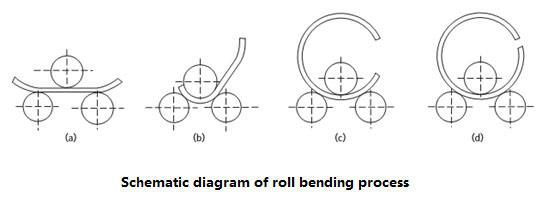3 Roll Bending Machine (Working Principle and Rolling Process)
3 Rolling machine rolling process
Obtain material
The material must be confirmed in accordance with the drawings and process requirements, and the surface of the material should not have obvious defects. Material quality and specifications should comply with relevant national standards and industry standards.
Delineate the boundary
When expanding, the barrel diameter must be the same as the actual diameter of the end shell, and the barrel material diameter should be calculated according to the middle diameter of the barrel.
The direction of the unfolded length should be the same as that of the rolled steel, and the limit position is 45°.
The alignment should be reasonable, making full use of the edge material and improving the utilization rate of steel.
When welding multiple sections of the cylinder, the welding seam should be properly configured according to the technical requirements of the equipment assembly welding.
End shell butt welds, cylindrical shell section longitudinal weld arc distance between the weld edges should be greater than three times the thickness of the cylinder and not less than 100mm.
When the cylinder is connected to the tube, bracket, reinforcing ring, bottom plate, etc., the insertion relationship of the longitudinal and circumferential welds on the cylinder should avoid the weld opening or too close to the reinforcing ring or bottom plate to cover the weld. Weld seam.
Drawing lines should be accurate, and a vertical line, bisector and bisector should be drawn using geometric mapping, not a square bus.
Leave the necessary margins and draw edge cut lines on the sheet metal first, then draw an actual material line and check the line.
Tolerance requirements for drawing lines for fading purposes.
The line drawing tolerance requirement for the height H of the cylinder is: H±1mm
The difference between the two diagonals △ L = L1 - L2 ≤ 2mm, the tolerance of the length of the cylindrical section L ± 3mm
Perimeter formula: L = π (Di + S), where Di is the diameter of the cylinder (mm), S is the thickness of the cylinder (mm).
After marking, make material marking transplant in the square of 100mm×100mm in the upper right corner of the steel plate.
Undercutting and edge treatment.
Carbon steel plate thickness <12mm, try to use shearing machine for undercutting (otherwise use semi-automatic shearing), clear slag and deburring after shearing.
When slotting is required, semi-automatic cutting machine or rolling chamfering machine is used when the plate thickness >6mm.
When the plate thickness is less than 6mm, grinding method is appropriate.
The bevel produced by flame cutting machine should be cleaned off the slag, and the welded bevel should not have defects such as cracks and delamination. The surface of the welded joint should be cleared of oxides, grease, slag and other harmful impurities before welding.
Gap range (calculated from the edge of the slot or plate) ≥ 20mm.
Pre-bending
Plate in the rolling, each end of the plate has a length of bendable due to non-contact with the upper roll, known as the residual straight edge.
Symmetrical bending, the remaining straight edge is usually about half of the center distance of the lower roll, also related to the plate thickness.
Asymmetric bending residual straight edge is about 1/6 to 1/10 of the symmetric bending.
This part of the remaining straight edge is difficult to completely eliminate during calibration, and is prone to quality and equipment accidents, and should be pre-bent.
If there is no pre-bending, you can use a template for calibration after the final roll.
The surface of the steel plate must be cleaned before bending, and the roll surface must not have rusty skin, hair, edges, or hard particles.
For example, when rolling stainless steel, the upper and lower rolls must be wrapped with a special layer of tape or paint, and the protective layer must not have hard particles.
Centered alignment
When the plate is put into the rolling machine, in order to prevent skew, the workpiece should be twisted and the main line of the workpiece should be parallel to the roller axis to ensure the quality of round rolling.
Rolling circle
Rolling circle is the main process of product forming, which is divided into one-feed and multi-feed process.
The number of feeds depends on the process (such as cold rolls are not allowed to exceed the maximum deformation rate allowed) and equipment limitations (such as anti-slip conditions and power conditions).
When the cold roll rebound is large, a certain amount of re-rolling must be added.
The longitudinal misalignment of the barrel end requires less than 1.5 mm.
The rolling process of the plate is shown in the figure below.

评论
发表评论